| August 2023- It's dental month! | | | Here are Orange Vet Hospital, we are celebrating dental month. Of course, every month is dental month, but we focus our staff training, promotions and case load on dentistry through the month of August. See below for dental specials.
Dr Georgia has recently been away to the ANZCVS Science Week, which is a big veterinary conference with lots of different streams. Georgia spent most of her time between the Small Animal and Equine rooms, covering many topics including atopy in cats, and caring for geriatric pets.
Dr Natasha is away at the moment, at the Centre for Veterinary Education conference focusing on all matters of the gastrointestinal tract; Tash is getting the cutting edge information on vomiting, diarrhoea, endoscopy and intestinal biopsies, as well as surgical case management, including exploratory laparotomy, and GDV (gastric dilatation and volvulus). | | | Book Online |
|
|
| Dental month promotions | | | Most pets start life with teeth, and with good care, for most pets we can try to keep them there! The most important part of dental care for pets is pain management- you know the pain of a tooth ache, but it is harder for a cat or dog to explain.
With dental month here now, we are offering:
- Free dental checks (book an appointment)
- 10% off dental scale and polish procedures
- 50% off dental x-rays
- Dental goodies with every dental
Dental x-rays are an important way to find out more about what is happening down the tooth root- it gives us about 50% more information than examination alone. Anaesthesia is required to perform dental x-ray your pet's teeth. Look at the detail we can see!
Call or book online today to make an appointment and an investment in your pet's health. | | | Book Online |
|
|
Dear Parkes residents,
We heard that you were without a vet, and we want to help. You can now book in for our trial consulting room in Parkes. With your support, we can continue this. If possible, please bring your pet's medical records, including vaccination details, so that everyone can be on the same page and make this as efficient as possible. Of course, if there is no paperwork, that is fine too- you will still be most welcome. Please note that surgical, after hours and hospitalisation cases will still be based in Orange, not Parkes.
Spread the word to those that need to know!
Looking forward to being able to help,
the Orange Vet Hospital team |
|
|
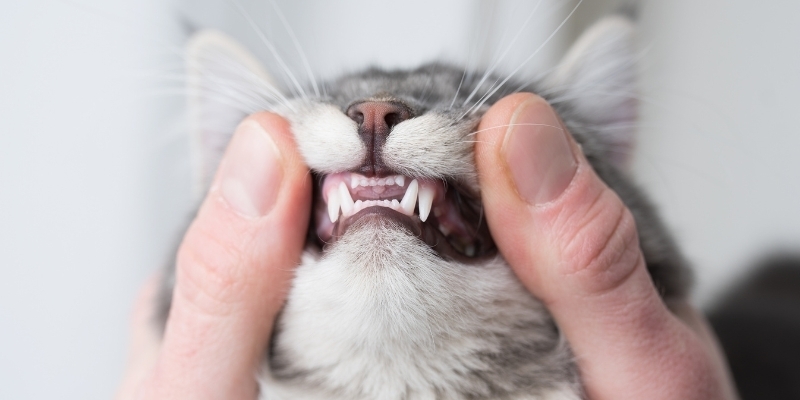 | | Feline a bit sore? | | | Has your cat been pickier with food lately?
Perhaps a bit touchy for any handling around their mouth?
Or have you noticed that their breath smells bad?
We know our cats can be experts at disguising their discomfort. Spot these changes? It's time your feline friend may need your help!
Here are three potential reasons why your cat's mouth could be sore:
Periodontal disease
Periodontal disease involves the progressive build-up of plaque (the gooey, bacteria-containing film that forms on unbrushed teeth), which eventually hardens into brown calculus. The gums become inflamed and sore (known as gingivitis), and this can progress to periodontitis, involving painful inflammation and infection around the tooth roots and jawbone. Eventually, affected teeth will become loose and may fall out.
Caught it early? Great! With a thorough dental clean under anaesthetic, we can effectively manage periodontal disease.
Feline gingivostomatitis
Feline gingivostomatitis involves an immune response to plaque, like a severe allergy, causing severe, long-lasting inflammation (and sometimes infection) of the gums and throat of affected cats.
These cats usually struggle to eat normally and appear generally lethargic and miserable. Often they stop grooming themselves. Cats can't tell us exactly, but the miserable nature seems to be caused by a mix of pain, swelling and disease.
It's possible to manage feline gingivostomatitis with regular dental cleans and high-level home dental care, but many affected cats require the surgical removal of most (or sometimes all) of their teeth to get relief.
FORLs
FORLs (feline odontoclastic resorptive lesions) are raw, painful tooth cavities that worsen over time. They are common in cats, with over half of felines over three years of age developing a FORL in at least one tooth.
Unlike human cavities, these lesions are not caused by eating sugary foods, but the exact cause is still unknown. It seems this could be an immune response to plaque and debris on the tooth and gumline.
Teeth affected by FORLs usually require complete or partial extraction (crown amputation).
Cat teeth issues can be severe! If you notice any symptoms of dental discomfort in your cat, book them for a prompt assessment with our knowledgeable vets. With the right treatment, we'll soon have them feline fine! |
|
|
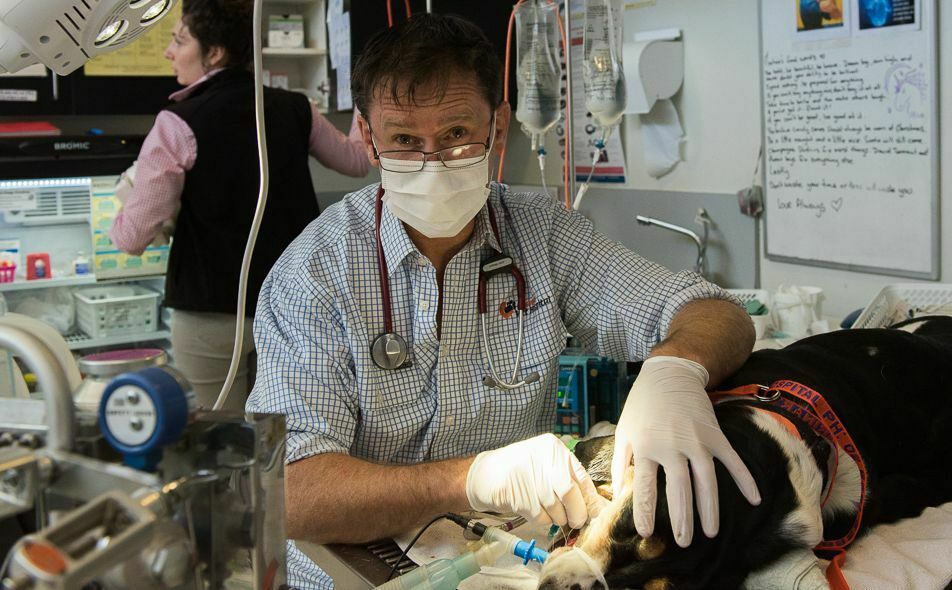 | | Why we don’t recommend anaesthesia-free dentistry | | |
“Why does my pet need an anaesthetic for dental work?” It’s a question we hear a lot, and it’s a great one! We recommend that all canine or feline dental procedures occur under general anaesthesia. Here’s why:
We can check your pet more thoroughly
For a thorough assessment of their oral health, pets should have all surfaces of their teeth checked, as well as their tongue, palate, jaws and throat opening. It’s also important to carefully measure the gum pockets around each tooth with a fine probe, as deeper than normal pockets suggest hidden disease around the tooth root.
We know very few pets who would tolerate these procedures while conscious, and understandably so- pets don't have the same mental thought patterns as humans, so they can't rationalise staying still for this type of procedure.
We can perform a better clean
We must clean both above and below the gumline of each tooth to remove all tartar and prevent the progression of dental disease. The insertion of dental instruments below the gumline can be uncomfortable, so most pets require a general anaesthetic for a thorough cleaning.
Anaesthetic reduces stress and pain for your pet
Even if your pet is generally tolerant and relaxed, the noises and vibrations of electric dental instruments combined with bright medical lights would likely be a scary experience for them (as well as for us humans!). Additionally, even a mild dental disease can cause increased tooth and gum sensitivity, which could make a simple clean painful.
Having your pet under anaesthetic ensures they feel no pain or stress during their procedure. It also allows us to administer pain relief medications and numbing nerve blocks if required so they recover comfortably too.
Without anaesthesia, we cannot radiograph your pet's teeth
If you've been to the dentist yourself, you know the value of what can be found with dental x-rays. Dental x-ray equipment is quite fragile, so cannot be bitten or chewed by pets. Without dental x-rays, we can only asses the top (easy) half of the tooth, not the underlying roots and bones.
In short, we believe that performing dental procedures under general anaesthesia is best for our animal patients, and that’s the tooth!
If you have any further concerns about anaesthesia or dental procedures for your pet, consult our caring vets. We can tailor anaesthesia plans for age, and other co-morbidities to make everything as safe as possible.
|
|
|
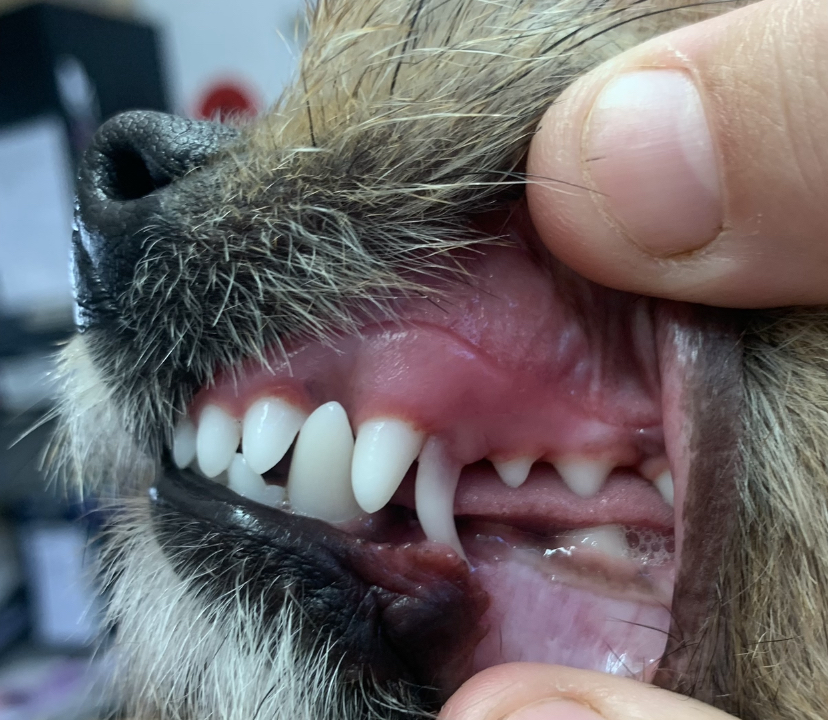 | | Too many teeth? | | | Did you know that dogs, and cats lose baby teeth, just like people? In fact, many animals do! But are too many teeth too much of a good thing?
1. Persistent deciduous teeth
At any one time, there should only be one of each tooth type in each spot. So having a baby tooth, and an adult tooth, is just too too many! We recommend extraction of the baby (also known as deciduous) tooth so that the adult tooth can fit into it's position without pain.
2. Supernumerary teeth
For some animals, the body can get a bit carried away when it gets to the phase of growing teeth. Decision making is a bit trickier for these ones- if the teeth are not over crowded, and the jaw is well aligned, it may be appropriate to leave the extra tooth or teeth where they are. Be guided by your veterinarian's recommendations.
3. Tooth- or something else?
You've seen the silly things that pets put in their mouth. It is part of the way that they explore the world. It isn't really surprising that along the way, sometimes 'things' get stuck in between teeth. The most common object we find between teeth is pieces of bone. These can become lodged between teeth, and even shift teeth, making for pain and build up of inflammatory calculus over time.
For more information on which teeth should and should not be present, consult our team – we’re passionate about pearly whites! |
|
|
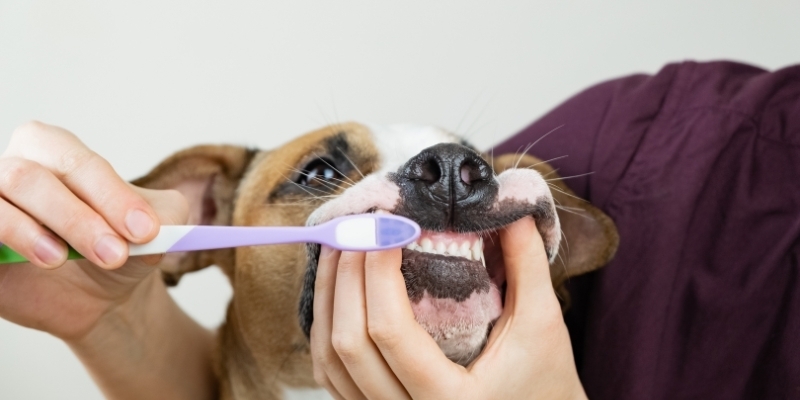 | | 3 Mistakes to avoid when brushing your pet’s teeth! | | | Did you know we recommend daily tooth brushing for dogs and cats as part of an ideal dental hygiene maintenance program?
If brushing your pet’s teeth seems impossible for you now, rest assured. With proper training and technique, most good-natured pets can be trained to accept regular brushing! This is easiest if you start in puppyhood.
Here are the 3 common mistakes to avoid when brushing your pet’s teeth.
1. Brushing when you should be booking a dental procedure
Do you only start trying to brush your pet’s teeth after discovering that your pet has a dental disease?
The issue with this is that if the pet has already developed gingivitis or periodontitis (inflammation around the gumline or tooth roots), brushing will be uncomfortable or even painful for the pet, which means they will likely resist the process.
If your pet has any visible gum redness, we recommend booking them for a prompt dental procedure under anaesthetic. This way, we can get them back to a healthy, comfortable state before you attempt any brushing.
The right time to start tooth brushing? As a puppy- make it a game! While you are teaching sit, and stay, add in some tooth brush training. Finger brushes and flavoured dog toothpaste make it more enjoyable for all. If you can get tooth brushing as part of your regular day for your pet, you should be able to keep the tooth fairy away!
2. Going too hard, too soon
Even if your pet’s mouth is comfortable, they are likely to find it too intense if you immediately try to scrub their teeth with no prior brush training.
We recommend easing your pet into the process with daily 30-60 second brushing sessions. Start with a face flannel over your finger for a gentler sensation the first few sessions, and once your pet accepts this, gradually upgrade to a very soft, moistened toothbrush. Remember to administer plenty of small, tasty treats throughout the process!
3. Trying to brush away calculus
Trying to scrub away that hard brown accumulation (known as calculus) that gradually forms on unbrushed teeth is tempting. Unfortunately, brushing won’t remove this hardened material. Sometimes it can b flicked off, but the areas to work on are the gumlines to reduce further tartar deposition. The brown bits are like barnacles on a boat- it has been there a long time!
Calculus is best removed with a proper dental scale and polish performed under anaesthetic, allowing us to clean both above and below the gumline properly.
For more information on keeping your pet’s teeth clean and healthy at home, consult our team – we’re passionate about pearly whites! |
|
|
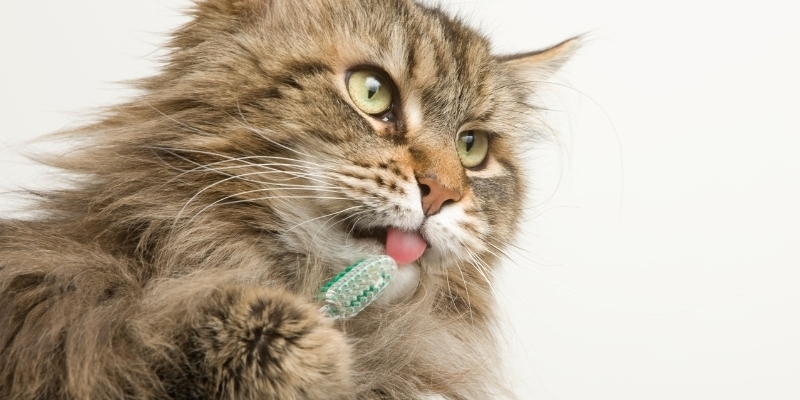 | | Make dental health gains the painless way! | | | At some point in your cat’s life, we may recommend that your pet undergoes dental extractions due to tooth fractures, abnormal tooth placement, or significant dental disease. Whilst this can be worrying news, our skilled vets will always ensure your pet experiences minimal discomfort.
Here’s how we will help keep your pet comfortable throughout the process.
Pre-procedural care
If we note significant dental disease in your pet (such as a tooth root abscess), we may recommend that they start on antibiotics and pain relief before their dental procedure.
We’ll dispense the right medication based on your pet’s pain level and general health. If your pet has known health issues or is older than 7years of age, we recommend blood tests to assess their organ health before the dental precedure so that we can plan the safest pain relief and anaesthetic protocol for them.
Pain control during the procedure
When you admit your pet to the hospital for their dental procedure, we will first administer a calming injection – a combination of pain relief and sedative medications.
Once your pet is under anaesthesia, if extractions are planned, we will perform targeted nerve blocks to numb certain regions of their mouth. Nerve blocks help patients have a smooth anaesthetic and minimise the pain once they awake.
We will review their case before we wake your pet again and administer additional “top-up” pain relief medications as necessary.
Aftercare
When your pet recovers sufficiently from their procedure, we will send them home with ongoing pain relief and dietary recommendations to support a comfortable healing process. We will tailor the pain relief plan if your pet is already on other medications.
Most pets will recover surprisingly quickly from dental extraction procedures. And of course, they feel a lot better after the removal of any painful teeth!
For more information on dental procedures for your pet, contact our helpful team. |
|
|
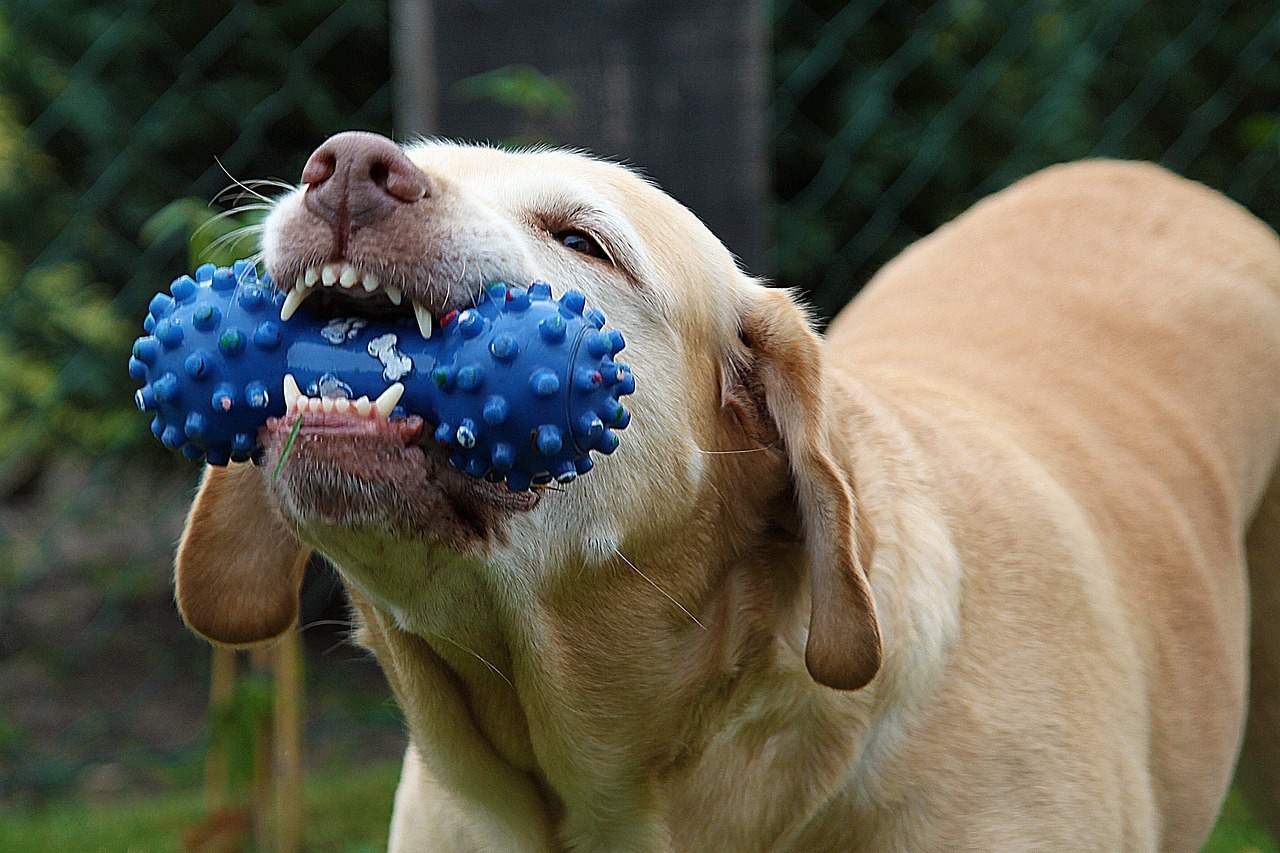 | | Dental safe toys | | | If you've gone through dental surgery on your pet, you'll be sure to keep your pet's pearly whites looking their best
1. Kongs, Buster balls and rubber toys are good
We really like toys that you can put food or spreads on- for most pets, they can be super keen on the food component, and not destroy the toy along the way. These give excellent enrichment for most food motivated pets, and can be a great way to pass time while you want to do other activities.
2. Use rubber balls, not Tennis balls
Chasing a ball can make for good exercise, when done in moderation. You've probably seen what most dogs do when they love balls and it is not thrown- they chew on it! This is no good for the life span of the ball, nor for the teeth if they are chewing on a Tennis ball. You see, the fluffy material on the outside of a Tennis ball is abrasive when chewed relentlessly. This means that over time, the white bits of the teeth get worn away and eroded over time, exposing the tooth pulp and leading to nasty, painful complications. Do away with Tennis balls today!
3. Bones- the jury is still out
Dogs evolved from wolves, and used to hunt deer and antelope and the like, chewing up all of the bits. Of course, bones were part of that. If you have a look at the average dog park in Orange, there are not wolves playing, but rather domesticated dogs- think Bulldogs, Dachshunds and Pugs. The differences for these breeds is that their faces, jaws and teeth are all very different from wild dogs from centuries gone by. Bones can make for great enrichment, and become part of a balanced diet. However, for the over enthusiastic dog, bones can be stronger than teeth and cause tooth fractures.
Tips on feeding an appropriate bone:
- Make sure it is a raw, uncooked bones. Smoking is still cooking!
- Choose a bone bigger than your pet's head- it makes it hard to gulp down!
- Try to feed uncut bones- the cutting makes for shapes that get stuck easier.
- Feed your pet less of their regular food if they get a bone.
- Discard of 'finished' bones before they become unsafe to eat (or start a fight)
4. Sticks- ok to chew on, fetch can cause dramas
If you ask your vet to recount their worst horror stick story, you'll be sure to be turned off sticks forever. Chewing on sticks, aka freelance mulching, seldom causes much drama. However, if you are throwing sticks for your pets to retrieve, it is a matter of time before you may see first hand what vet-stick horror stories look like.
It is important, whichever form of toys you choose, to supervise your pet. Even with the best intentions and doing your homework before buying new toys, some pets are just a bit too keen and find themselves in trouble with toys.
Call us today to book regular checks with our knowledgeable team to help keep your pet happy and healthy. |
|
|
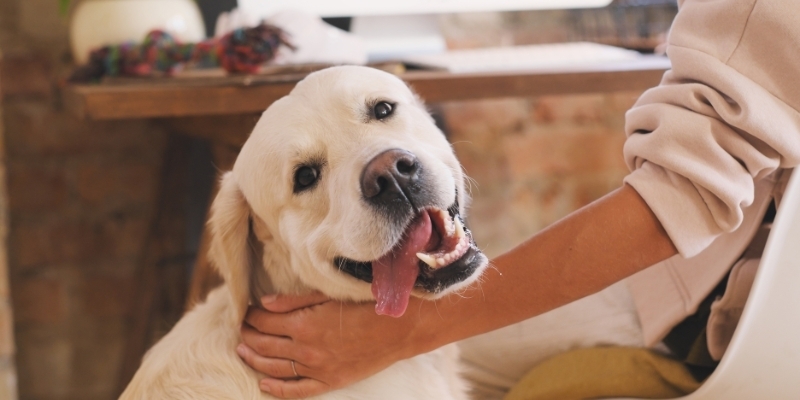 | | Why we recommend regular rechecks | | | Ever wonder why we recommend a dental check-up with your pet every 6-12 months, even if they seem to be in tip-top shape? Here are 3 reasons why!
1. If we check your pets’ teeth regularly, we can detect dental diseases earlier
Periodontal disease (inflammation and infection around your pet’s gums, tooth roots and jaws) starts with reversible gum inflammation. With regular dental checks, we can detect periodontal disease and other developing diseases in your pet earlier and perform a prompt dental clean to remove plaque and calculus above and below the gumline.
Prompt thorough cleaning means that:
- We can reverse any early periodontal disease and get your pet’s mouth back to a healthy, comfortable state
- If teeth are permanently damaged, we can extract them promptly to prevent your pet suffering long-term pain and infection
- We can provide personalised advice on how to best keep your pet’s mouth clean and healthy at home between dental procedures
2. We may detect other health problems earlier
When our vets thoroughly check your pet’s mouth and jaws, we can sometimes detect other health issues that may not have been obvious otherwise.
Such issues could include:
- Lumps in your pet’s mouth
- Tongue and mouth ulcers
- Broken teeth
3. We can build a better relationship with your pet and be more proactive about their general health
You might bring your pet to see us when they’re ill or injured. However, when your pets miss out on regular check-ups, we miss the opportunity to make proactive healthcare recommendations to help keep them well! As well as guidance on dental health, we can also advise on the following:
- Parasite control
- Healthy body condition
- Vaccination routines
- Any new lumps on your pet’s body
- Joint health
Not to mention, if we see your pet routinely when they’re well, we’ll be able to give them lots of treats and cuddles, helping them to be more comfortable for future vet visits.
Call us today to book regular checks with our knowledgeable team to help keep your pet happy and healthy. |
|
|
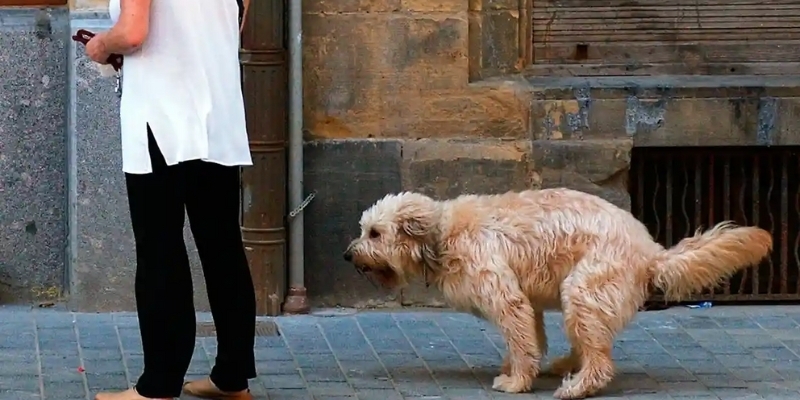 | | Animal News In Brief | | | French Mayor hopes to catch problem-poopers with pet DNA tests
The city of Beziers in France has introduced a controversial "genetic passport" scheme to combat the issue of dog owners failing to clean up their pets' feces. The plan, launched by Mayor Robert Menard, requires dog owners to have their pets DNA registered, allowing authorities to identify and fine those who do not clean up after their dogs.
The move comes in response to the increasing problem of dog waste in public spaces, with the mayor hoping that the threat of fines will encourage responsible ownership and cleaner streets. "We did a count, and we pick up more than 1,000 messes a month, sometimes a lot more, just in the town centre. It just cannot go on," said Mayor Menard. The new system requires pet owners to provide an animal DNA sample which local police may use to identify the perpetrators of mysterious local pet poops. Once matched, those brazen enough to leave a 'surprise' steaming on the public pavement can expect a bill of up to 122 euros (roughly AUD 200). Dog owners of Beziers will be required to carry a genetic "passport" for their pets and, if caught in public (with their pets) without that passport, face a fine of 38 euros (close to AUD 60).
However, Francophile dog lovers planning a trip to Beziers needn't hasten to cancel their plans. Mayor Menard confirmed that non-residents and visitors would not receive fines for lack of such a passport. "Foreigners aren't the problem", he said, "it's the locals who aren't cleaning up".
To find out more about Bezier's genetic passport plan, read The Guardian's full article. Who thinks this is a good idea on Orange streets (and front lawns)?
Photo: TNT Magazine/Alamy
Guide Dogs Australia’s rush to pair vision-impaired woman with new dog, Ava
After two decades of travelling confidently with various guide dogs by her side, senior disability advocate Donna Purcell faced a significant challenge when her beloved guide dog and friend, Dora, unexpectedly passed away last year. For the first time in 20 years, Donna found herself without the support she had grown accustomed to. Once easy journeys now required careful planning, and even her daily train trips became anxiety-inducing. The matching process with a new guide dog can take months, and while waiting, Donna had to revert to using a cane, which she had rarely done since getting her first guide dog.
Relying on a cane made moving around the city slower, sometimes requiring good samaritan assistance. "I'm okay using a cane in my local environment, [but] catching public transport and navigating through Central Station, which is always changing and under construction, is something I just don't feel confident doing," said Donna. While some vision-impaired people prefer to use a cane, a guide dog offers unique benefits such as navigating around objects and, generally, enabling travel at a swifter pace. "We were looking for a dog for Donna that was going to be good on all public transport [and in] office environments... a fast confident walker... and they don't come around every day," said Guide Dogs Australia Instructor Doug Richie.
Eventually, after extensive lifestyle, personality and walking assessment, Guide Dogs Australia matched Donna with Ava, and the pair are due to begin their first month of training together. "[I'm excited about] the absolute freedom that having a guide dog is going to bring back into my life," said Ms Purcell.
Click here to read the ABC News' coverage of Donna and Ava's journey to success.
‘Moore’ dogs than Robert expected: Hundreds of dogs at 100th birthday pet parade
Meet the Moore family of San Jose, California. They planned to make their father Robert's 100th birthday special, but with many of Robert Moore's friends no longer with them, daughter Alison felt it important to organise something besides a family dinner. Robert's birthday wish was straightforward: to sit outside and pet a few dogs.
Alison took to social media, with a general invitation to dog owners of San Jose to join a pet parade in the Moore’s neighbourhood on Robert’s birthday. The family expected a handful of local pets and their owners to participate, but not much more than that. However, on June 17th, Robert was greeted by a queue of more than 200 dogs waiting patiently for pats. Some dogs had travelled over 10 miles (16 km) to join the parade with their owners. There were dogs of all breeds and sizes, some with disabilities, all on their best behaviour, sporting flowers, birthday cards and lots of waggy tails. "So many strangers showed up," said Robert's granddaughter, Caroline Moore, "Not only did they show up, but they made cards and posters, [and] brought him cupcakes. It was the most heartwarming thing ever."
Robert enjoyed the pooch parade for nearly two hours, smiling and petting every dog in attendance. "He was so overwhelmed," said Alison Moore, "He was just so sweet and talking to the kids and petting all the dogs and saying their names. It was so much fun."
As for the final verdict from the birthday boy himself? "It was a special, special birthday parade," said Robert, "because of all the numbers and all the different breeds of dogs".
To check out cute pictures from the pup parade, view the full article by The Washington Post. |
|
|
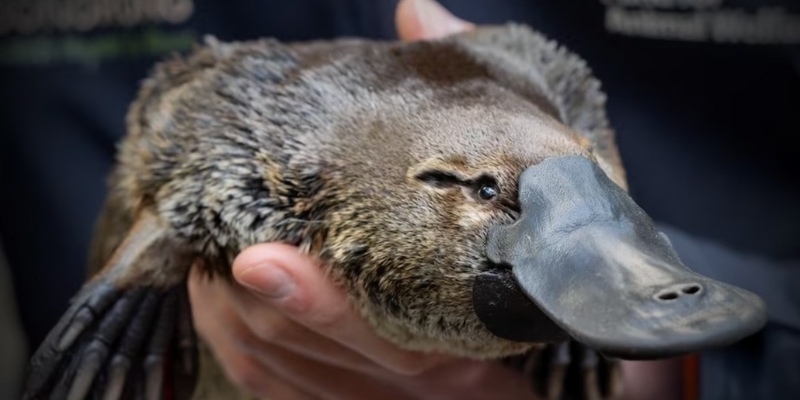 | | “Do it for Larila” Hobart Primary students push for platypus conservation | | | Local Hobartians were devastated by the death of 'Larila' the platypus late last year. Larila, named after the palawa kani word for 'platypus', lived in the Hobart Rivulet (which joins the Derwent Estuary). She was known locally after appearing in a viral video in 2021. Six months later, locals rushed Larila to an animal rescue centre. A stray piece of twine had entangled itself around her body, embedding so deeply into her skin that it required surgical removal. Hobartians held high hopes for her recovery, but sadly Larila died the week following her surgery.
Pollution continues to threaten Australian wildlife, alongside climate change, drought, the damming of rivers, poor water management, and invasive species such as foxes, according to Dr Gilad Bino, platypus biologist and senior lecturer at the Centre for Ecosystem Science at the University of NSW. "Either at a national or a state level you need a conservation plan for when the next drought hits. If need be, we might need to undertake interventions and rescues." said Dr Bino.
Of course, anybody can support the health of the platypus' habitat by practising conservation at grassroots level, from simple actions like putting rubbish in the bin to organising large-scale cleanup working bees, as the children of Hobart Primary School have done. "In a perfect world, the platypi and other creatures in the rivulet would be OK ... we don't live in a perfect world, but if we all make a choice to be kind to the environment and animals, we can all work together to make that happen," said Ellis, a Hobart Primary student. "We need to remember to think about our animals — rubbish in the bin, pick it up if it's on the ground, even if it's not yours — and remember Larila. Do it for her."
Read (and watch!) the captivating audiovisual article at ABC News. |
|
|
Have a question for our team to be answered in our newsletter? Send us an email to our email address orangevet@orangevet.com.au or reply to this email and we can do our best to answer. Dogs, cats, pocket pets, horses, large animals: all make for good questions that we are happy to help with. |
|
|
This email contains comments of a general nature only and is not intended to be a substitute for professional veterinary advice. It should not be relied on as the basis for whether you do or don't do anything.
All content © PetPack 2022 |
|
|
This email was sent to:
email@example.com
Orange Veterinary Hospital
57 Molong Rd
Orange, NSW 2800
|
|
|
|